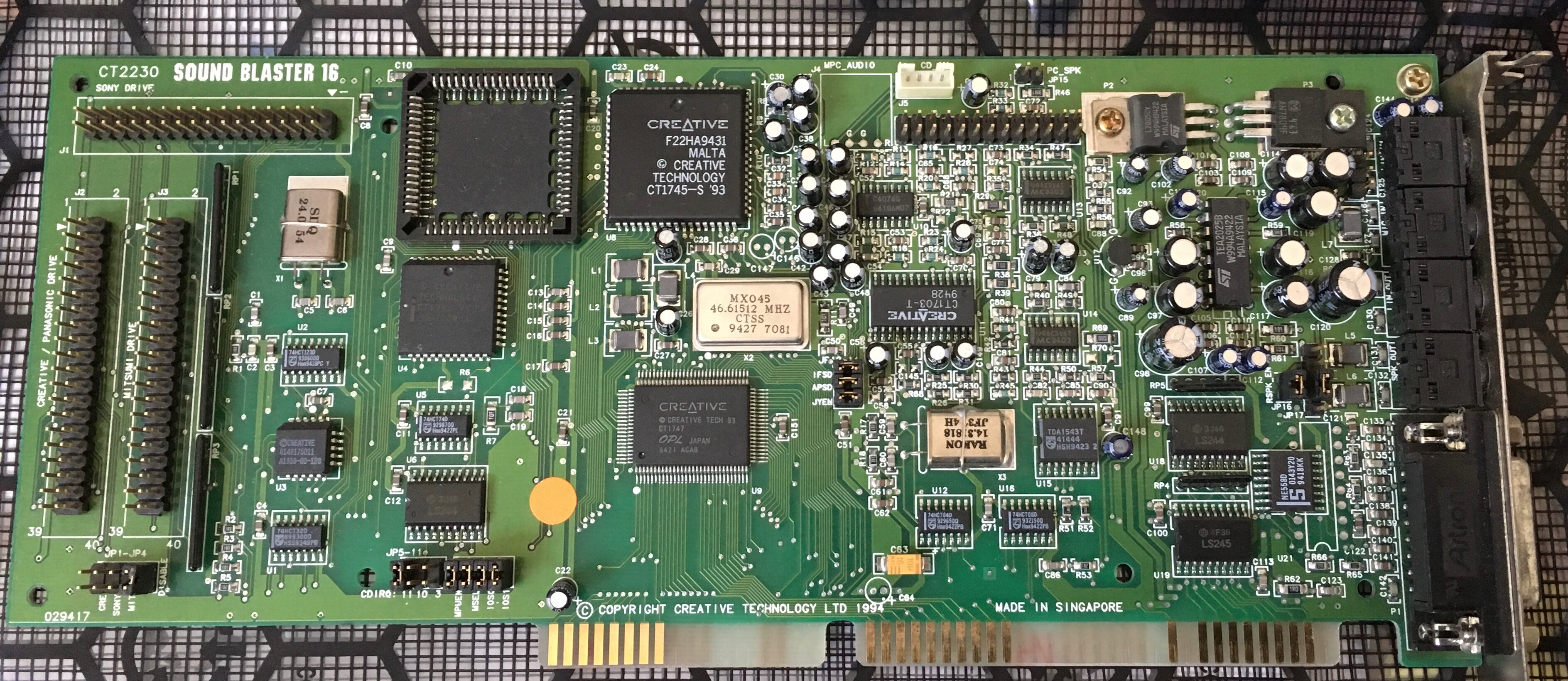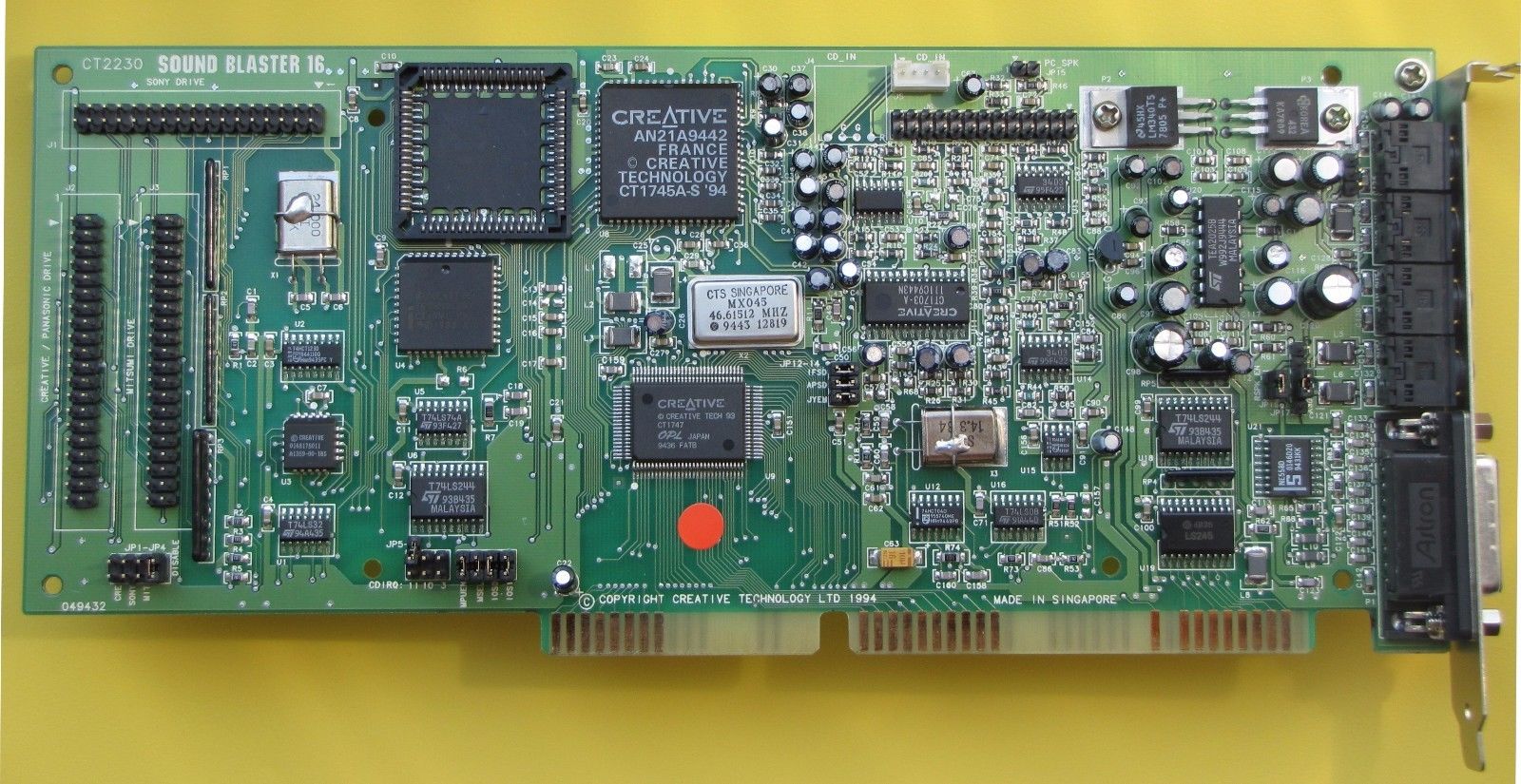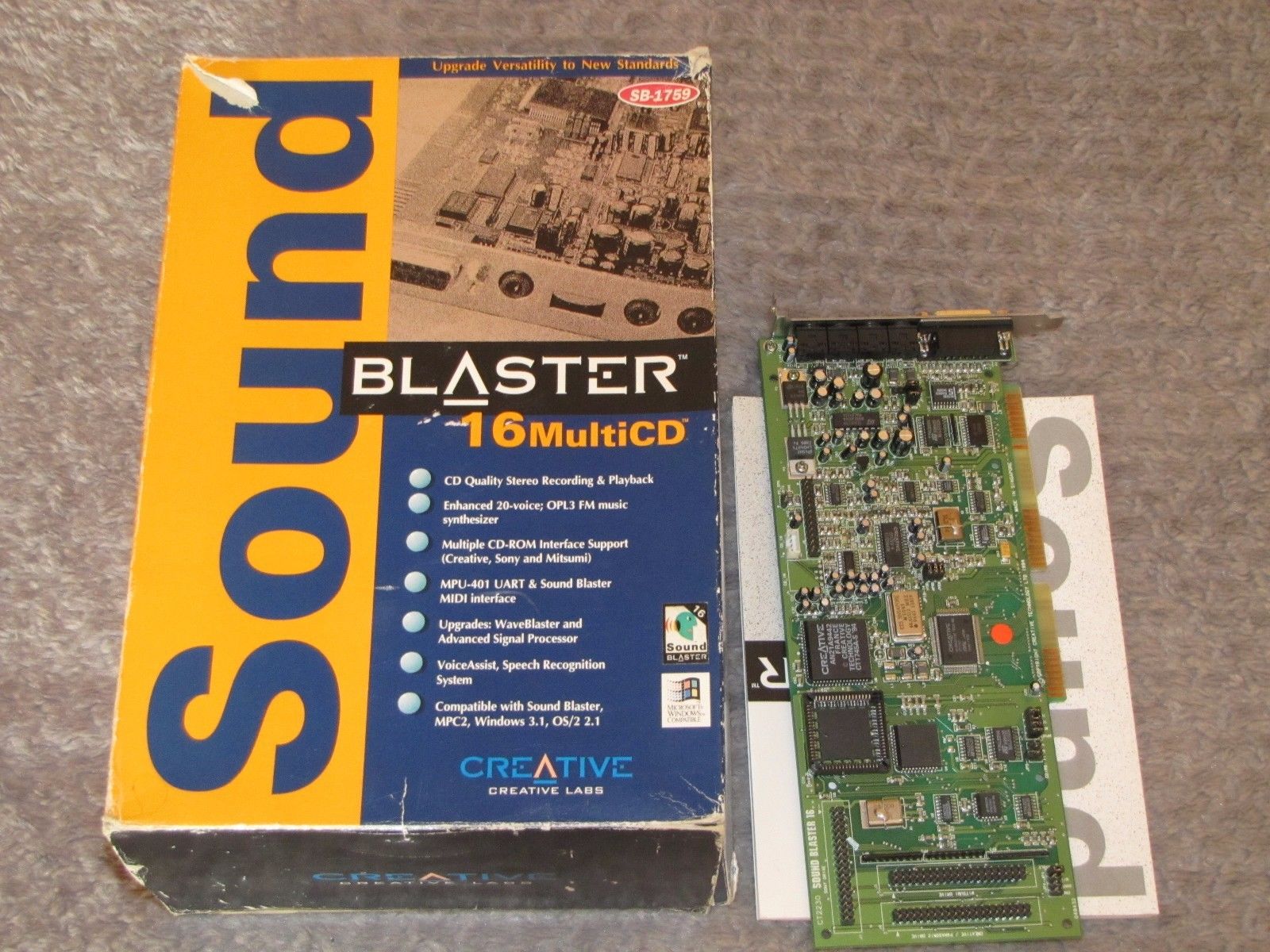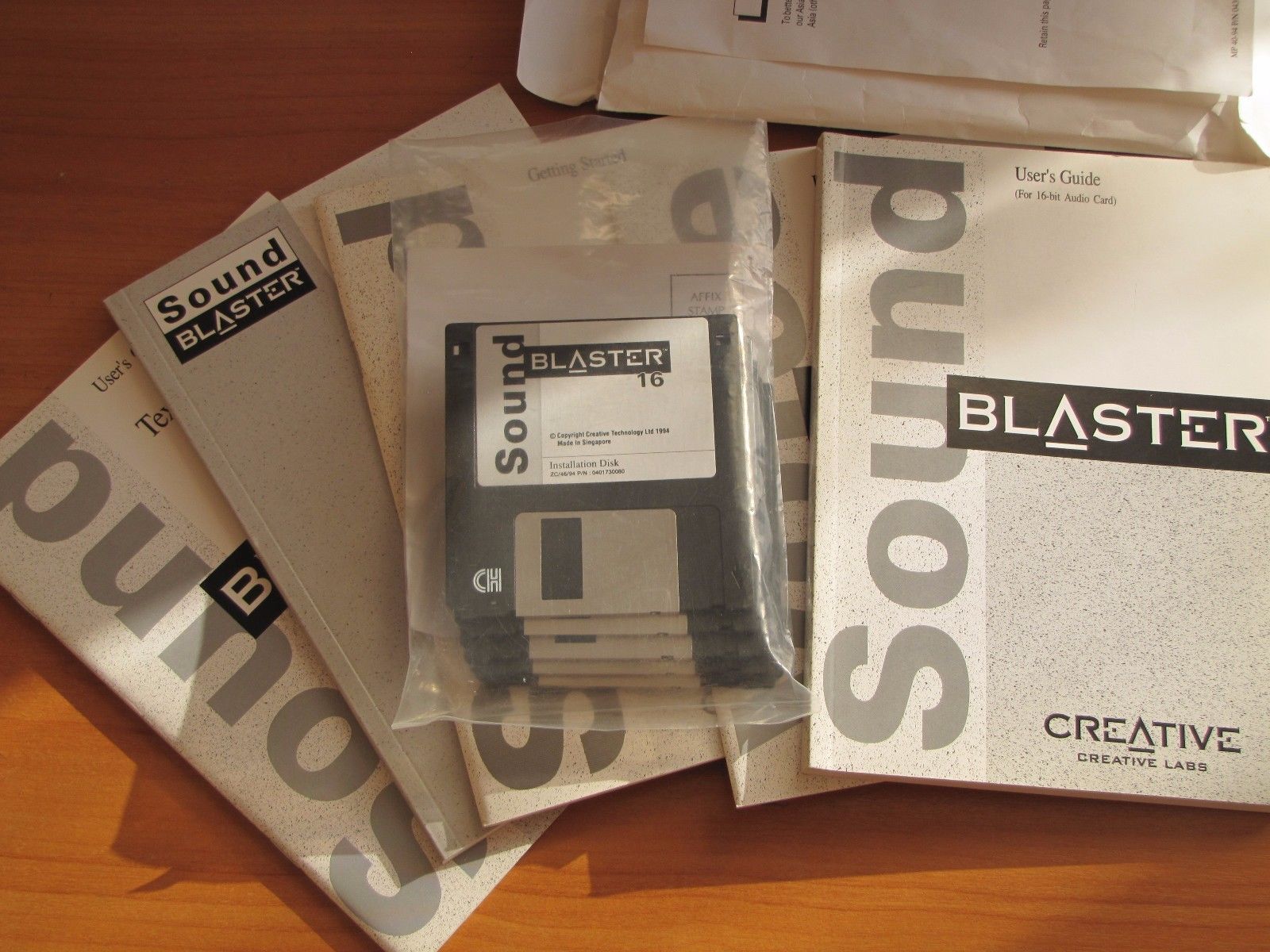Sound Blaster 16 (CT2230, CT2239, CT2920, CT2929)
Kicking off the 2nd generation of Sound Blaster 16 cards was the CT2230, arriving in late 1994. These came with an integrated Yamaha FM synthesizer in a new ASIC, the CT1747. Because it was actual Yamaha hardware within, it got the "OPL" logo stamped on it.
|
Released | 1994 |
| Bus | ISA 16-bit | |
| FM Synth | (Integrated Yamaha YMF262 in CT1747) | |
| Audio Codec | None | |
| Standards | Ad Lib, Sound Blaster, Sound Blaster Pro, Sound Blaster 16 | |
| Ports | Speaker-Out, Mic-In, Line-In, Line-Out Game/MIDI port |
|
| CD-ROM | Panasonic, Sony and Mitsumi | |
| Wavetable | Wave Blaster header | |
| Plug & Play | No (Auto-Init only) | |
| FCC ID(s) | IBACT-SB16L2M | |
| Price | Jun 1994: $169 | |
| See Also | Sound Blaster 16 (CT2290), Sound Blaster 16 (CT1770) |
The CT2230, full name Sound Blaster 16 MCD ASP (Multi-CD with ASP chip) was the first of the 2nd-generation Sound Blaster 16 cards. Like the late 1st-gen CT1750 it got Panasonic, Sony and Mitsumi CD-ROM interface headers.
The card also provided a Line-Out jack for cleaner audio that bypassed the onboard amplifier for those with powered speakers - something lacking on all the 1st-gen cards. One sad omission on the 2nd-gen cards was the deletion of the thumbwheel volume control.
For these cards, read the Noise Issues section on the main Sound Blaster 16 page.
The CT2239 was identical to the CT2230 but was marketed without the CSP/ASP chip. Other variants of the CT2239 exist such as the CT2239S which replaced all the other CD-ROM interfaces with a single Sony CD-ROM interface, and CT2239M which came only with the Mitsumi CD-ROM interface. As with most "sub-models" like the CT2239, don't expect the model number on the silk-screen to identify it as a CT2239 - these will always just refer back to the base model, i.e. CT2230.
The CT2920 was a very similar card to the CT2230 - I don't have any more information or screenshots for this card, nor its OEM variant, CT2929.
Board Revisions
Known board revisions include 19413, 29417, and 49432.
They all got the
CT1741 DSP chip, though DSP versions differed between variants - either 4.11 or 4.13 (both with hanging note bug).
Board revision 19413 got the old CT1745A. Rev 29417 got either the old CT1745A mixer chip from the first generation, or the newer CT1745-S.
Board revision 49432 got the even later CT1745A-S.
Some CT2230 cards (board revision 49432) do not get header pins on both the Sony and Mitsumi CD-ROM headers, leaving the Panasonic header as the only one you can use.
Competition
The Sound Blaster 16's primary enhancement over its predecessor (the Sound Blaster Pro) was its capability to playback 16-bit audio for a crisper, cleaner sound. Unfortunately, this wasn't heavily adopted by games developers who continued to use lower-quality samples. Because of this, buying a Sound Blaster 16 really didn't offer any benefit over a much cheaper 8-bit audio card unless you were into recording your own stuff. The marketing department at Creative Labs didn't care, however, and people bought Sound Blaster 16s like they were going out of fashion, thinking 16 bits were always twice as good as 8.
In 1994, there was plenty to choose from in the ISA sound card market, with a lot of new cards to choose from. Gravis released the UltraSound Max which added a Crystal CS4231A-KL codec to their wavetable, finally giving the UltraSound backward-compatibility with Ad Lib, Sound Blaster and Sound Blaster Pro. Another card new this year that sported the same Crystal chip was the MediaTrix AudioTrix Pro which also came with a 2 MB onboard wavetable and the new Yamaha OPL4 chip.
Lots of off-brand cards sporting other Crystal chipsets [CS4215, CS4216 and CS4248] were also out in large quantities.
ESS Technologies' introduced their second audio chipset, ES688, with five-channel mixer and 16-bit stereo recording and playback capability.
OPTi launched the successor to their 82C928 'MAD16' chipset with the 82C929A MAD16 Pro, which was essentially the same but added an MPU-401 UART and IDE CD-ROM interfaces.
New from the MediaVision camp were the Pro Sonic 16 SCSI, Pro 3D/Premium 3D, Deluxe and Deluxe 16 cards, all of which leveraged their new Jazz16 chipset. The Pro 3D and Premium 3D were the first to offer SRS Surround Sound on a sound card - something Creative Labs had not yet done.
Turtle Beach released their first 2nd-generation cards that comprised Tahiti, Rio wavetable daughterboard, and Monterey (a packaged up Tahiti and Rio combined) - all great, but didn't have the crucial backward compatibility with Ad Lib and Sound Blaster standards.
In the Media
Setting it Up
Downloads
Operation Manual Get in touch if you can provide this missing item! |
DOS and Windows 3.1 Utility Disks The original Sound Blaster 16 DOS and Windows 3.1 installation disks, marked Sound Blaster 16 |
. DOS and Windows 3.1 Utility Disks The original Sound Blaster 16/AWE DOS and Windows 3.1 installation disks, marked SDR-31STD-1-US (Revision 1). |
More Pictures

Sound Blaster 16 (CT2230, board revision 29417)

Sound Blaster 16 (CT2230, board revision 49432)


Sound
Blaster 16 box and contents (CT2230)
.png)